The combination of sport specialization and high-volume training has been associated with a high rate of overuse injuries in youth athletes. Because of this, multiple medical and professional organizations have recently released position statements warning against specialization and have given recommendations for safe sport participation in youth [1-5].
In Case You Missed It…
If you haven’t read Part 1, Part 2, Part 3, and Part 4 of this article series on early sport specialization, I advise finding a bit of time to do so. You can view them here, here, here, and here... and you can thank me later.
Part 1: A review of the research investigating the true odds of becoming a collegiate or professional athlete.
Part 2: Whether or not early sport specialization leads to long-term athletic success.
Part 3: How early sport specialization increases injury risk and can lead to athlete burnout.
Part 4: 5 simple strategies to prevent athlete burnout.
Now, onto the current article:
The 3 Sport Volume Recommendations for Youth Athletes
Previous research has identified two major training/sport volume recommendations for youth athletes related to months per year and hours per week of sport participation, which have been endorsed by medical and professional organizations such as the American Academy of Pediatrics (AAP), the American Orthopedic Society for Sports Medicine (AOSSM), and the NBA and USA basketball [1-4]. These training/sport recommendations include, (1) youth athletes should not play one sport more than eight months per year, (2) youth athletes should not participate in more hours of organized sport per week than their age (i.e. a 10-year-old should not participate in more than 10 hours of organized sport per week), and (3) youth athletes should not participate in multiple leagues of the same or different sports at the same time [1, 2, 6, 7]. In their recent position statement on long-term athletic development, the National Strength and Conditioning Association (NSCA) also suggests that children diversify their sport-related experiences to promote health and overall athletic development [8]. By noting the research in this statement, the NSCA also conveys support for the aforementioned volume recommendations [8].

The Influences of Coaches and Parents
Coaches and parents have been shown to be the primary influencers of a youth athlete’s decision to perform intense training, or specialize, in a single sport [9]. It’s clear that parenting and coaching behaviors influence the sport and/or physical activity experiences of the youth athlete [10-14]. Therefore, it’s imperative that coaches and parents understand the evidence-based training/sport volume recommendations to ensure safe sport participation. There’s one glaring problem; most parents and coaches are unaware of these recommend ions.
In a recent survey of 1,000 parents of youth athletes, Bell et al. (2018) asked the parents about their knowledge and attitudes of sport volume recommendations and sport specialization attitudes [15]. The authors reported that 82.2%, 84.5%, and 89.9% of parents weren’t aware of the sport volume recommendations for months per year, hours per week, and simultaneous participation in more than one league at a time, respectively [15].

A similar survey was conducted by Post et al. (2018) to evaluate the knowledge of 253 youth sport coaches regarding sport volume recommendations, and attitudes and beliefs towards sport [16]. Comparable results to those obtained from parents were reported in this cohort; 79.4%, 79.3% and 77.6% of youth sport coaches weren’t aware of the sport volume recommendations for months per year, hours per week, and simultaneous participation in more than one league at a time, respectively. Interestingly, although 58.3% of coaches felt that it was appropriate for youth athletes to participate in more than one league at a time when the sports were different, only 18.2% felt it was appropriate when the leagues were of the same sport [16].

The Goal
My intent is not to call out parents and youth sport coaches for their lack of knowledge in this area. The purpose of the article is to address this knowledge gap and to relay the evidence-based guidelines aimed at promoting long-term physical, mental, and psychosocial health of youth athletes. Today’s society is potent in misinformation and, more importantly, lack of evidence-based information, which is circulating on social media and web platforms. It’s a lofty goal to expect parents and coaches to rummage through the diluted symphony of myths and facts in order to obtain accurate advice. Hopefully, this article joins the team of evidence-based sources surrounding youth sport in the fight against the sea of prevailing myth monsters who continue to lurk in the waters.
In the final article of this series, I’ll discuss the potential impact that organized youth sport, and early sport specialization in particular, can have on the family unit.
Enjoying the Content?
Instantly become an important part of the Shakebot community by connecting with me on social media:




Reference
- Brenner, J.S., 2016. Sports specialization and intensive training in young athletes. Pediatrics, 138(3), p.e20162148.
- Brenner, J.S., 2007. Overuse injuries, overtraining, and burnout in child and adolescent athletes. Pediatrics, 119(6), pp.1242-1245.
- LaPrade, R.F., Agel, J., Baker, J., Brenner, J.S., Cordasco, F.A., Côté, J., Engebretsen, L., Feeley, B.T., Gould, D., Hainline, B. and Hewett, T.E., 2016. AOSSM early sport specialization consensus statement. Orthopaedic journal of sports medicine, 4(4), p.2325967116644241.
- DiFiori, J.P., Güllich, A., Brenner, J.S., Côté, J., Hainline, B., Ryan, E. and Malina, R.M., 2018. The NBA and Youth Basketball: Recommendations for Promoting a Healthy and Positive Experience. Sports Medicine, pp.1-13.
- Bell, D.R., Post, E.G., Biese, K., Bay, C. and McLeod, T.V., 2018. Sport Specialization and Risk of Overuse Injuries: A Systematic Review With Meta-analysis. Pediatrics, p.e20180657.
- Olsen, S.J., Fleisig, G.S., Dun, S., Loftice, J. and Andrews, J.R., 2006. Risk factors for shoulder and elbow injuries in adolescent baseball pitchers. The American journal of sports medicine, 34(6), pp.905-912.
- Jayanthi, N.A., LaBella, C.R., Fischer, D., Pasulka, J. and Dugas, L.R., 2015. Sports-specialized intensive training and the risk of injury in young athletes: a clinical case-control study. The American journal of sports medicine, 43(4), pp.794-801.
- Lloyd, R.S., Cronin, J.B., Faigenbaum, A.D., Haff, G.G., Howard, R., Kraemer, W.J., Micheli, L.J., Myer, G.D. and Oliver, J.L., 2016. National Strength and Conditioning Association position statement on long-term athletic development. Journal of Strength and Conditioning Research, 30(6), pp.1491-1509.
- Baxter-Jones, A.D.G. and Maffulli, N., 2003. Parental influence on sport participation in elite young athletes. Journal of sports medicine and physical fitness, 43(2), p.250.
- Fraser-Thomas, J.L., Côté, J. and Deakin, J., 2005. Youth sport programs: An avenue to foster positive youth development. Physical Education & Sport Pedagogy, 10(1), pp.19-40.
- Sallis, J.F., Prochaska, J.J. and Taylor, W.C., 2000. A review of correlates of physical activity of children and adolescents. Medicine and science in sports and exercise, 32(5), pp.963-975.
- Dempsey, J.M., Kimiecik, J.C. and Horn, T.S., 1993. Parental influence on children’s moderate to vigorous physical activity participation: An expectancy-value approach. Pediatric Exercise Science, 5(2), pp.151-167.
- Padaki, A.S., Popkin, C.A., Hodgins, J.L., Kovacevic, D., Lynch, T.S. and Ahmad, C.S., 2017. Factors that drive youth specialization. Sports health, 9(6), pp.532-536.
- Padaki, A.S., Ahmad, C.S., Hodgins, J.L., Kovacevic, D., Lynch, T.S. and Popkin, C.A., 2017. Quantifying Parental Influence on Youth Athlete Specialization: A Survey of Athletes’ Parents. Orthopaedic journal of sports medicine, 5(9), p.2325967117729147.
- Bell, D.R., Post, E.G., Trigsted, S.M., Schaefer, D.A., McGuine, T.A. and Brooks, M.A., 2018. Parents’ Awareness and Perceptions of Sport Specialization and Injury Prevention Recommendations. Clinical journal of sport medicine: official journal of the Canadian Academy of Sport Medicine.
- Post, E.G., Trigsted, S.M., Schaefer, D.A., Cadmus-Bertram, L.A., Watson, A.M., McGuine, T.A., Brooks, M.A. and Bell, D.R., 2018. Knowledge, Attitudes, and Beliefs of Youth Sports Coaches Regarding Sport Volume Recommendations and Sport Specialization. Journal of strength and conditioning.



